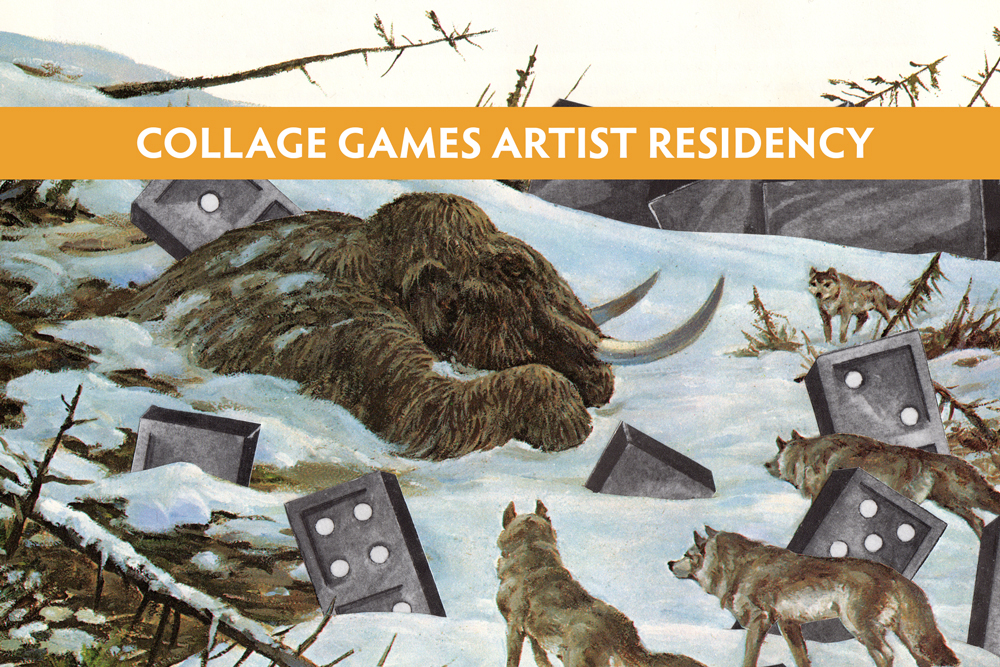
RESIDENCY UPDATE
Collage Games Artist Residency
16-20 September 2024, New Orleans
A week-long, in-person residency in which artists will explore how to adapt their collage practice to game design or incorporate games and play as a theme in their artwork.
Play is a critical part of being human. Play is how we try new things, discover new skills, and incorporate new ways of being. Play can also reinforce social bonds and bring us into community with others. As Mr. Rogers explained, “It’s the things we play with and the people who help us play that make a great difference in our lives.” For artists, play is serious business, an integral part of the creative process. In the mid-1920s, European Surrealists met in cafes and played collaborative drawing and collage games like Exquisite Corpse. Mel Gooding writes, in the introduction to Alastair Brotchie’s A Book of Surrealist Games: “The Surrealists initiated the most radically liberating critique of reason of the century. Their brilliant investigations were conducted through art and polemic, manifesto and demonstration, love and politics. But most specially and remarkably, it was through games, play, techniques of surprise and methodologies of the fantastic that they subverted academic modes of enquiry, and undermined the complacent certainties of the reasonable and respectable. Playful procedures and systematic stratagems provided keys to unlock the door to the unconscious and to release the visual and verbal poetry of collective creativity.”
Kolaj Institute sees games as both a tool for artist development and a strategy that can be used to share one’s artwork with their communities. “We can think of board and card games as works of art in and of themselves,” wrote Kolaj Institute Director Ric Kasini Kadour. “Goal setting and rule making create a micro-cosmology that combined with strong visual elements set a stage for people to come together and play with one another. Using collage to make games is a brilliant use of the medium and one that can bring an artist’s work to new communities.”
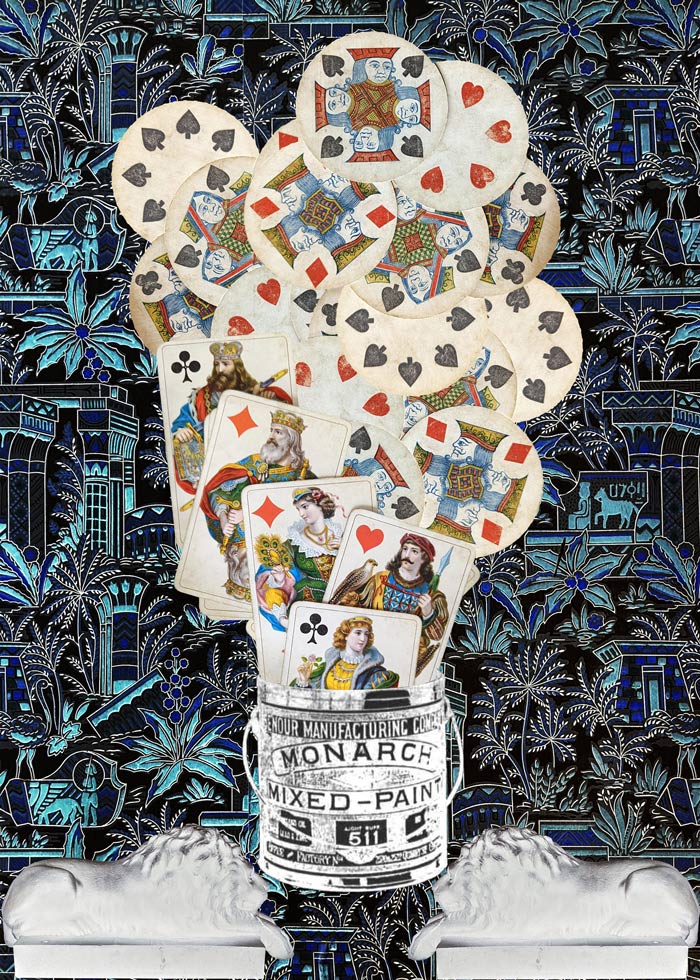
15″x11″; collage; 2022. Courtesy of the artist.
In The Tale of Genji, 11th-century Japanese noblewoman and lady-in-waiting Murasaki Shikibu wrote about the leisurely lives of Emperor Kiritsubo’s courtiers. Among their pastimes was kai-awase, a simple game played with painted clam shells. The goal was to find the matching shells. The game had been around a few centuries by the time of Shikibu’s writing and the shells became artistic endeavors themselves, luxuriously painted and adorned with gold. An 18th-century set in the collection of the Metropolitan Museum of Art shows scenes from Shikibu’s writing. We mention this to underscore the long history of art and games. From the block-printed, 15th-century Mamluk cards in Egypt to nature artist Catherine Hamilton’s painterly board game Evolution, the game has been a place for art.
Whether we’re talking about board games, video games, or tabletop roleplaying games, the gaming world has always been intrinsically linked with art. Art is sometimes the first thing someone sees or notices about a game before purchasing and playing it. Designing the box the game comes in, the cards used, the 3D renderings of landscapes and characters, and even the dice. All of these things pass through an artist’s hands at one point or another. But for the most part, the medium has had its roots in drawing and painting. “Collage is there if you look for it,” writes Kolaj Institute Coordinator Christopher Kurts. “Sometimes in the process or the presentation, rarely ever in the mechanics of the game itself. But I think now is the perfect time to infect the gaming world with collage.” Wizards of the Coast, the company that owns Magic the Gathering and Dungeons & Dragons, has recently come under fire for using AI to replace its artists. What better way to subvert this trend than to introduce collage to the ecosystem of games?
Current gaming culture is already moving in the direction of more art-focused materials. You can find apps that use collage to create games, like Downpour and Landing. Lyric games like We Are But Worms: A One Word RPG, in which the concept is more important than playability, are gaining steam. Zines have been a staple of tabletop roleplaying games since the 70s, with pages packed full of art and ideas to inspire the game master. Modern games like Mork Borg are pushing the boundaries between layout, art, and game design. Authors are using public domain images to illustrate their games, which is in sync with the collage artists’ ethos.
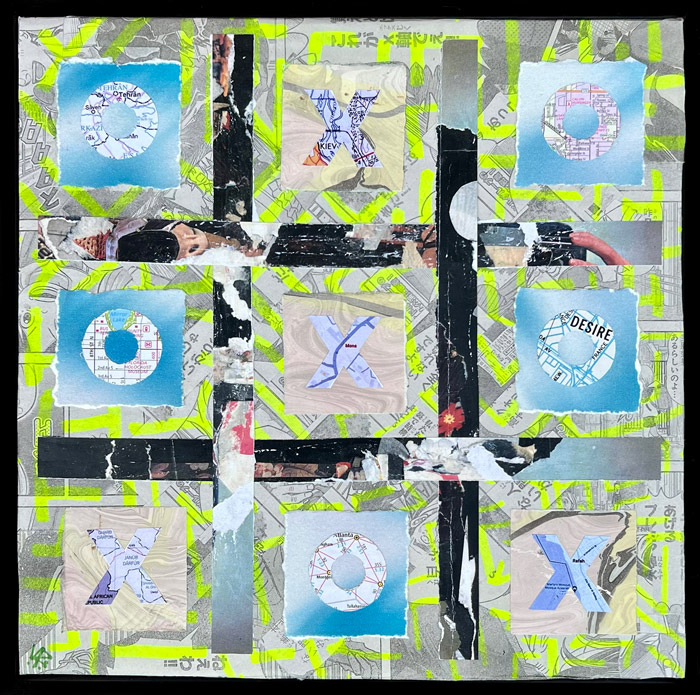
Games are an incredible tool for storytelling, worldbuilding, and social engagement. In this residency, we will explore the history of collage and games, gaming and play as a theme for artwork, and brainstorm and workshop our ideas together. We will have dedicated time for playtesting them with each other as well as with gamers who are not artists in order to get feedback from varied sources. We will talk about collage as art assets and illustrations for games, games that use collage as a mechanic, and game diffusion models.
Christopher Kurts will lead the residency. He is a board game enthusiast and has been running, playing, and creating his own tabletop roleplaying games for almost 30 years. Recently, he ran Collage Game Night at Kolaj Fest New Orleans 2024, a live event that satirized competition in the arts while centering play and fun in art making and collaboration. He is also working on his own tabletop roleplaying game that uses collage as a core mechanic and is always looking for collaborators. “I’m hoping that through this residency we can build a like-minded community of artists that want to create a movement of collage in game design that isn’t just hidden in the background. I want designers to declare loudly, this is a collage game!”
We are looking for artists who either want to create their own game that relies heavily on collage, create collage that is meant to illustrate a game, or create artwork that uses games and play as a central theme. Artists will leave the residency with a plan for finishing and distributing their games or artwork. At Kolaj Fest New Orleans 2025 residency artists will be invited to debut their games.
PARTICIPATING ARTISTS
Kolaj Institute is excited to announce the three artists from across the United States who were selected to participate in this five-day residency in New Orleans.
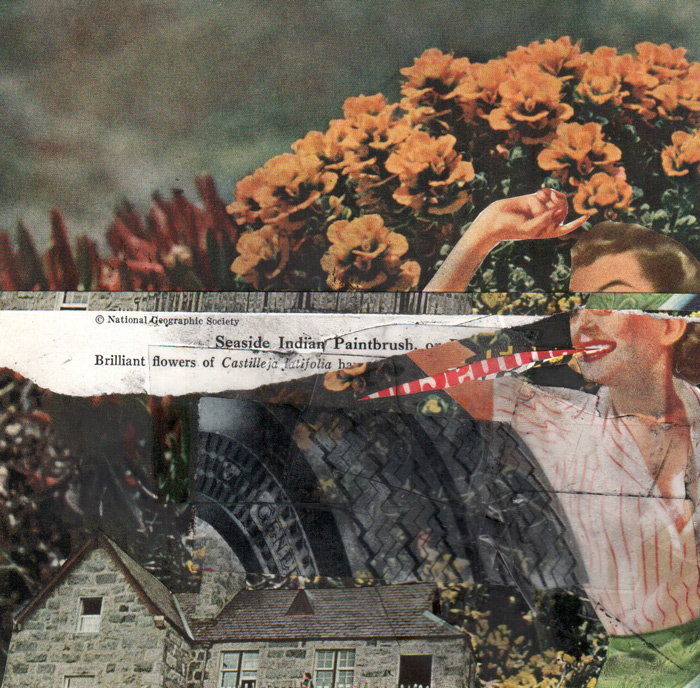
5.5″x5.5″; collaborative mixed media collage with tape transfer; 2023. Courtesy of the artist.
Anastasia “Stacy” Kirages, a Houston-based collage artist and zinester, explores themes of memory, history, nostalgia, and preservation. In her work, she utilizes found ephemera through collage and zine-making to reflect on her own family history and relationships and to create fictionalized memories in new contexts. The artist earned an M.Ed in Reading Education from Texas Woman’s University and a BA in Art History from the University of Texas at Austin. This past year she enjoyed teaching a class about zines and analog making in the Photo & Digital Media Block Program at the University of Houston. Currently, she runs a monthly collage meet-up group with artist Chasity Porter called Scissors of Texas/Tijeras de Tejas and has also been a lead organizer for Zine Fest Houston (ZFH) since 2013. In addition to her work with ZFH, she volunteers with Black & Pink, Girls Rock Camp Houston, and Montrose Grace Place. Her work has been shown nationally and internationally.
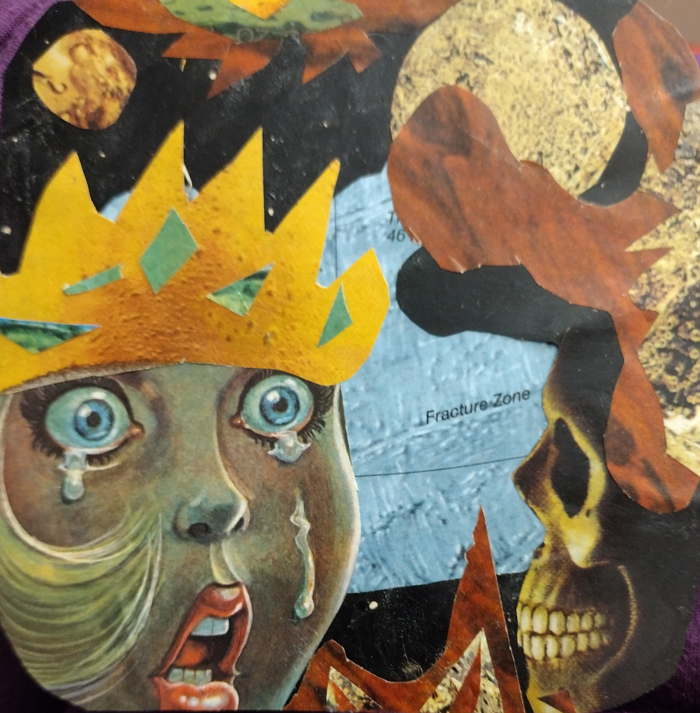
2023. Courtesy of the artist.
Noah Matuszewski was born and raised in Delaware County, PA. As far back as he can remember, he has always been intrigued by games. When he discovered Dungeons & Dragons, he realized he could combine his love of problem-solving, play, and storytelling to create fantastical new worlds and characters. As an adult, Matuszewski has acted as both a DM and a player in a variety of game systems and rule sets. In the past year, he has created his own gaming company, OddGoblinGaming, where he and a co-collaborator write and create home-brewed modules for different RPGs.
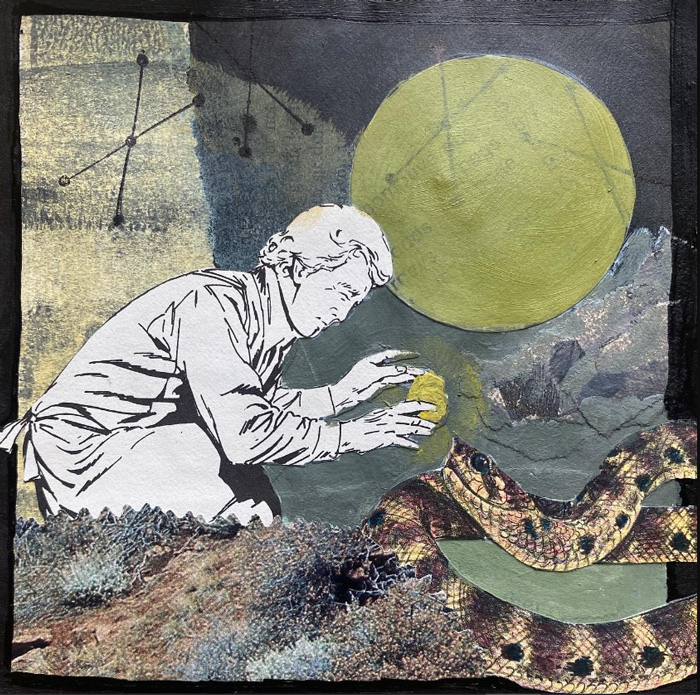
6″x6″; mixed media collage on canvas; 2022. Courtesy of the artist.
Leah Peterson is a mixed media artist building colorful worlds inhabited by all types of people, animals, and imaginary creatures. Each work invites you to join the characters exploring their domains. Peterson has always been inspired by the natural world and is grateful to work in a studio in Vermont with a window looking out at a lake, sky, mountainside, and birds of all shapes and sizes. Peterson is also inspired by old books, especially illustrated children’s early reading texts. Since 2022, Peterson has had original works for sale at the gallery of the Third Branch Pottery Studio on Main Street in Randolph, Vermont. She had a solo exhibit of collages on book covers at the Chelsea Public Library in Chelsea, Vermont from July 1, 2024-August 30, 2024. She has also had pieces in shows at Studio Place Arts in Barre, Vermont (Spring 2024) and Snow Farm in Williamsburg, Massachusetts (Fall 2023). Peterson has been an active member of Collage-Lab since 2020 and has taught online collage workshops in the Spring Fling events in 2022 and 2023. Workshops included: Deliberate Progress: Organizing Your Artistic Journey, Rules: Meant to Be Broken?, and Stepping into the Unknown: Collage, Storytelling, and Fantasy.
FACULTY
Christopher Kurts is a storyteller and artist in New Orleans, Louisiana. He is the Coordinator for Kolaj Institute, where he has organized artist labs, residencies, workshops, and forums which have often led to exhibitions and publications. In this role, Kurts acted as the Art Director for Kolaj Institute’s Oh, Money! Money! by Eleanor H. Porter, illustrated and interpreted by contemporary collage artists. Kurts is also the co-founder and lead organizer for the Mystic Krewe of Scissors and Glue, a group of creatives in New Orleans who meet monthly to collage, converse, and foster community. Along with the Krewe, Kurts helped organize the inaugural Paper Parade in January 2024, a Mardi Gras walking parade devoted to collage. His own work recently appeared in the exhibition, “Sewage & Water Board Billing Issues: Collage by New Orleans Artists” which debuted in June 2024 during the Kolaj Fest in New Orleans, Louisiana, USA. christopherkurts.com
